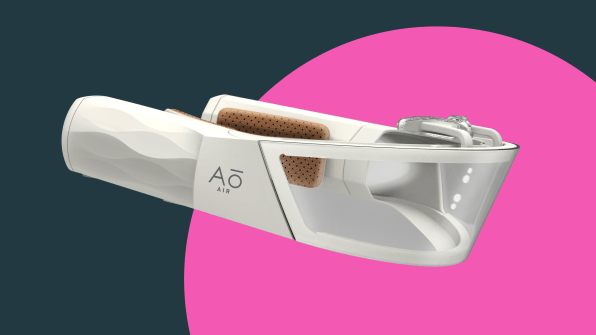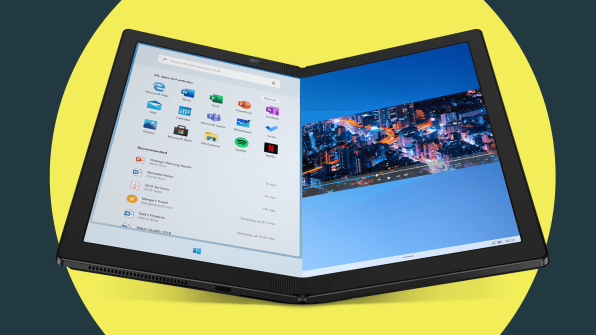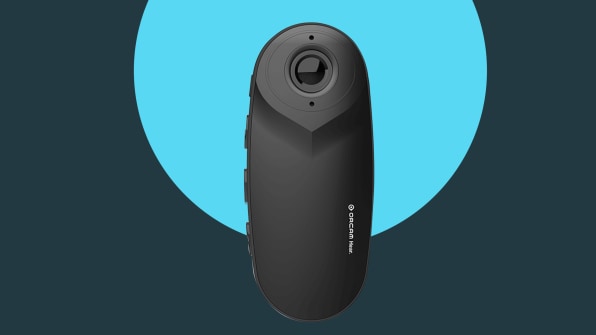Every January, the annual Consumer Electronics Show snaps the tech press out of its holiday stupor to fly to Las Vegas and walk through aisle after aisle of new televisions, robots, and plain old weird gadgets that are all billed as the next big thing.
I’ve been to CES. Many times. And I can tell you, the sheer corporate thirst on display is exhausting. But I’ll also admit, there is almost no better portrait of our times than when businesses reflect our values back at us in the form of must-have products. No year was that more clear than it was this year, with gadgets that have been designed, not just with normal iterative improvements in mind, but with the promise to filter our unbreathable air or critique our self-pleasure.
Here are the big trends lurking in the new products of CES 2020.
Dystopian design
Talking to experts across food, architecture, and design late last year, they all agreed that the environment would be the chief focus of design for the next decade. We’re seeing that play out at CES this year in a variety of dystopia-ready products—the sorts of things that would have been hard to imagine even existing a few years ago.

Take the Atmos mask. It’s a $350 personal air filter, worn on your face, that uses filters and fans to give your mouth and nose its own clean air bubble in a polluted world. And in an effort to reduce plastic bottle consumption, companies are promising big countertop machines to improve water—from your tap. We saw this late last year with a $555 filter from the Swiss company Lang, and now, with the New York company Rocean. Another company called Hydraloop wants to make sure you don’t waste extra water, so for $4,000, the refrigerator-sized device promises to recycle your used “grey water” from sources such as your shower into nondrinking applications such as your washing machine or toilet. And of course, no dystopia would be complete without a new way to eat: Impossible debuted a new pork product at the show, which will be slowly rolling out at restaurants and grocery stores over the next year (though most analysis points out that this is Impossible’s play for the Chinese market, which consumes 50% of all pork globally each year). In any case, it apparently tastes pretty good.

Foldable everything
In theory, a phone or tablet that folds in half is better than one that doesn’t, and it allows you an ergonomic flexibility that was lost in the iPhone era of hard, glass devices that feature big, rigid screens.
Now, after years of companies showing off wonky tech demos, the foldable screen revolution is finally, really here. Late last year brought the new folding Razr, and Samsung is rumored to be announcing its second foldable phone in about a month. At CES, we saw a duo of folding laptop concepts from Dell. Sure, these are still concepts, so who knows if they’ll ever be produced? But Dell is not exactly known for cutting-edge design so the company likely sees the writing on the wall: Folding screens will become ubiquitous. Lenovo debuted the ThinkPad X1 Fold, a foldable 13.3-inch laptop that will be available later this year for $2,500. The entire thing is one big display, and the interface looks well-articulated, with a screen that can pop up a virtual keyboard like a laptop when it’s folded halfway. Finally, TCL—the company you probably know best for making the super cheap 4K TVs that you see advertised on Black Friday—debuted a series of smartphones that will all cost under $500 this year. A folding concept shown alongside them won’t come out in 2020. But if TCL is eyeing this market, it means folding displays will go from premium devices to budget-friendly products fast.
Design that whitewashes privacy invasions
Invisible design and inclusive design have been some of the most important design trends of the past five years. Inclusive design has enabled companies such as Microsoft to build products that work for everyone, not just the able-bodied, and invisible design, which rests on seamless user experiences, has helped disrupt everything from retail to transportation.
But technologies that we’ve equated with these approaches—vision and voice, in particular—have come with a cost to our privacy. I’m beginning to doubt that any company, no matter how righteous, can protect the data it collects, and at CES, I get the sense that the tech industry is leveraging the halo of inclusivity to whitewash the surveillance state.
The OrCam Hear is an AI-infused wearable camera that links to a Bluetooth headset. The idea is that it can see who is talking to you and boost just their frequency so that you can hear them. It’s clever and could truly help people who are hearing impaired. But it also means that someone will be wearing the equivalent of a Ring doorbell around their neck, watching you even as you merely walk by.

We see this happening in travel too. You have Delta promising custom “parallel reality displays,” which, in a pilot project in Detroit, will magically aim pixels right at your eyes, to show people their individual flight information instead of a big board of hundreds of flights. The tacit promise is that no one will have to squint at tiny lettering on the big board ever again. But you’ll have to scan your ticket to opt in (for now—Chinese airports are already scanning your face for checking in). American Airlines announced it will begin using the Google Assistant’s interpreter mode to translate languages for flyers in their Admirals Club. Conversations with the airline’s concierge who checks you in and can assist with flights will get easier, sure—but a portion of this private space will be recorded.
Finally, there’s what’s happening in the intimacy industry. The Lioness 2 vibrator tracks your orgasms, measuring their strength, comparing them to orgasms from other people, and offering tips for maximizing intensity. “Which is cool,” one of my female colleagues scoffed, “because then it’s another way for women to be rated and judged or maybe have some shame about if their number isn’t high enough?” Not to be outdone, men are getting a “taint bandaid” from a company called Morari, which uses localized electrical signals to delay premature ejaculation. For $25 next year, the device can be controlled with an accompanying smartphone app or, apparently, even a Fitbit. I can’t imagine what could possibly go wrong.








